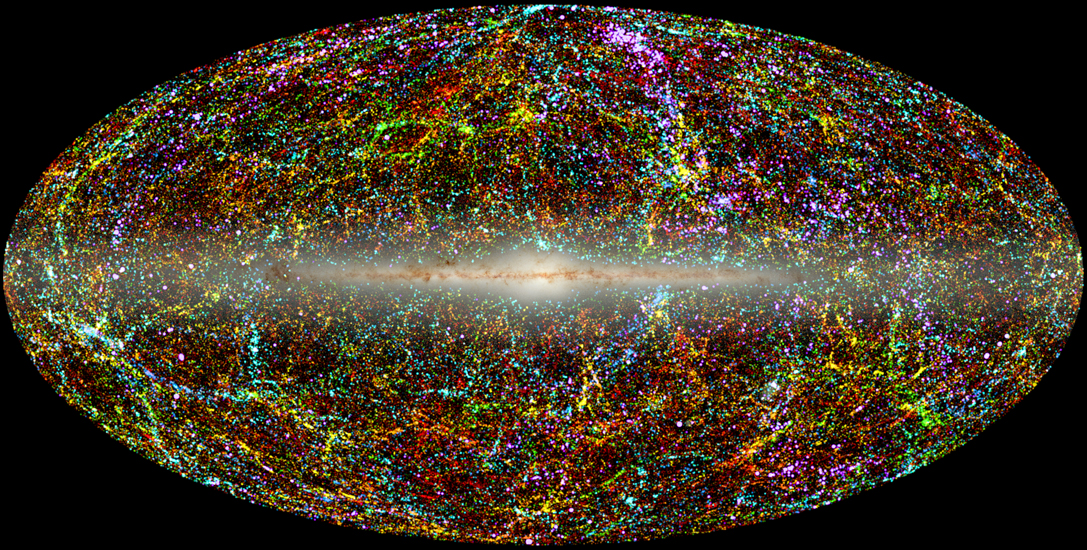Cassandra, for Richard:
How do we know the laws of physics are universal? Why can’t there be a far-off galaxy where our laws of physics don’t apply? (Is that a really stupid question?)
 Richard, for Cassandra:
Richard, for Cassandra:
We don’t. There can. (It’s not.)
Such was Cassie’s contribution to LWON’s first anniversary post last May. As part of the celebration, each member of the masthead asked one of the other members a question that would serve as the topic of a future post. Now that LWON’s second anniversary is nigh—the new challenge will appear Monday—I figure I’d better answer her questions. (If we were asking one another questions again this year—alas, we’re not—mine would go to Cassie: How come you got to ask me two? [Actually, three?])
First question: How do we know the laws of physics are universal?
 We don’t. We only suspect that they are.
We don’t. We only suspect that they are.
The idea of universal laws dates to Copernicus. Ancient astronomers had divided the universe into two parts, each with its own laws of physics. In the celestial realm, heavenly bodies moved in circles, travelling along transparent spheres. In the terrestrial realm, objects moved in straight lines, falling toward the center of the Earth. When Copernicus wrenched the Earth from the center of the cosmos and sent it and the five planets (Mercury, Venus, Mars, Jupiter, Saturn) into orbit around the Sun, he didn’t just arrive at a math that more closely matched the motions of the heavenly bodies. He also erased the distinction between terrestrial and celestial. Newton finished the job a century and a half later by deriving laws of gravitation that were, he claimed, universal.
After Einstein gently amended Newton’s laws through the general theory of relativity, in 1915, he and other theorists naturally wondered whether his laws, too, are universal. In attempting to answer the question, they first made the same assumption as Copernicus: The Earth doesn’t occupy a privileged position in the universe. This Copernican Principle meant that the universe must be, in the terminology of physics, isotropic and homogeneous: It will look the same in every direction no matter where you are in it.
The assumption was ad hoc, from the Latin for for this, as in: For this purpose. According to Richard Tolman’s 1934 Relativity, Thermal Dynamics, and Cosmology, one of the few academic texts on general relativity even until the 1970s, the purpose of assuming an isotropic and homogeneous universe was “primarily in order to secure a definite and relatively simple mathematical model, rather than to secure a correspondence to known reality.” The ad hoc nature of the assumption—this cavalier attitude toward the correspondence to how the universe actually looks—was precisely what prompted several generations of scientists to regard cosmology not as physics but as metaphysics.
But then—there it was: how the universe actually looks.
One of the consequences of the Big Bang interpretation of the universe is that when the universe was 379,000 years old, it would have cooled enough for hydrogen atoms and photons to decouple and go their separate ways. That moment would have survived as a sort of snapshot, only after all this time the expansion of space would have stretched the light from the image all the way into the microwave end of the electromagnetic spectrum. The discovery of this cosmic microwave background in 1964, and then numerous observations of the CMB at finer and finer levels of resolution, have revealed a Copernican cosmos: a universe that looks the same in every direction no matter where you are in it. Meaning that the laws of physics would be the same no matter where are you in the universe.
Which brings me to Cassie’s second question: Why can’t there be a far-off galaxy where our laws of physics don’t apply?
There can. We can’t actually prove that the laws of physics are universal. We can only find further and further supporting evidence, and no evidence has supported that hypothesis more than the ongoing investigations into the CMB. Still, the possibility exists that one day we’ll find an exception. That’s the way science works, and indeed that’s the way some scientists spend their working lives.
Case in point: the Hubble bubble. If we happen to inhabit an unusually low-density portion of the universe, then an adjacent higher-density portion of the universe might be gravitationally stretching our local space in a way that would explain what most scientists have come to accept as an acceleration in the expansion of the universe (better known as dark energy). Or so the anti-Copernican, pro-privileged hypothesis goes.
A paper last year in Physics Review Letters, however, found that galaxy surveys show the universe is indeed homogeneous on a scale up to a gigaparsec, or 3 billion light years. But what about more than a gigaparsec? Might the universe not be homogeneous on a scale of, say, 4 billion light years? The authors of that paper, Pengjie Zhang at the Shanghai Astronomical Observatory and Albert Stebbins at Fermilab, argue that in a Hubble bubble universe (deep breath) temperature shifts due to electron-photon, aka inverse Compton, scattering would be greater than we would expect in a “regular” universe, but that CMB observations don’t show such a large shift, and we can therefore conclude that such a scenario is extremely unlikely.
But the short answer? Sure!
Which brings me to:
(Is that a really stupid question?)
(It’s actually rather profound. Let’s say we found that the universe isn’t homogeneous and isotropic on a scale of 4 billion light years—or 6, or 8, or 13. Would we have to abandon the laws of physics as we know them? Maybe. But far more likely is that most—and very possibly all—physicists would make the assumption that “as we know them” is the problem, and that once we knew the laws of physics better, they would be universal again. Such an assumption, of course, would be ad hoc—but hey! It’s worked before.)
* * *
Galaxy distribution image: Wide-Field Infrared Survey Explorer (WISE)/The Two Micron Sky Survey (2MASS). The galaxies are color-coded by their distances—blue being nearest, then green, then red. Our Milky Way galaxy is at the center.

I might need to take physics class to understand your explanation, but I get your main point loud and clear. I could be right. So I sent a link to my husband and told him to suck it!
His response: “ok, we don’t KNOW it, we only suspect it … because EVERY TIME we looked somewhere it has been true. AND, while overturning theories is the stuff of science, the suspicion that basic laws of nature are universal is fundamental to science as an effort, as a way of seeing the world. but yeah, we’re not sure. we’re never ever sure. ever.”
I can’t wait until we find that weird galaxy. I’m already rehearsing my most annoying “I told you so.”
But as soon as we find that weird galaxy, and my wife’s full-throated “I told you so” echoes through the halls of science, everybody will start trying to come up with a new law that takes that weird galaxy into account, so that once again we’ll have a universal law. My bet: they’ll find it.